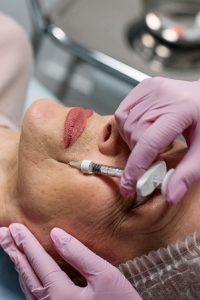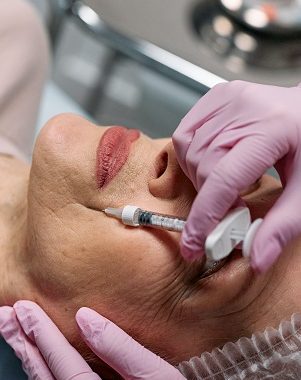
Acne scars can linger long after the breakouts have cleared, affecting confidence and prompting a quest for effective treatments. In this guide, we explore the diverse landscape of acne scar injections, covering everything from filler options to FDA-approved treatments and potential side effects. Discover the latest in skincare science and find the best injection for your unique needs.
Understanding Acne Scars:
Acne scars are not a one-size-fits-all concern, and comprehending the diverse types is paramount before embarking on any treatment journey. This nuanced understanding ensures that the chosen interventions are tailored to the specific challenges presented by different scar types.
-
Boxcar Scars:
- Characteristics: Boxcar scars are broad, U-shaped depressions with well-defined edges.
- Challenges: Their larger surface area and defined borders make them more amenable to certain treatments but may require a combination of approaches for optimal results.
-
Ice Pick Scars:
- Characteristics: Deep, narrow, and pitted, resembling small puncture wounds.
- Challenges: Due to their depth, ice pick scars pose unique challenges, requiring precision in treatment to address the underlying scar tissue effectively.
-
Atrophic Scars:
- Characteristics: Atrophic scars result in a loss of tissue, leading to depressions in the skin.
- Challenges: These scars may vary in size and depth, demanding a customized approach to restore volume and smooth the skin’s surface.
Understanding these distinctions allows dermatologists to tailor treatments to the specific characteristics of each scar. Furthermore, combining treatments to address multiple scar types concurrently is often a strategic approach for achieving comprehensive and satisfying results.
As individuals may have a combination of these scars, a personalized treatment plan, guided by a dermatologist’s expertise, becomes crucial. Whether opting for filler injections, chemical peels, or other interventions, aligning the treatment with the specific challenges posed by boxcar, ice pick, and atrophic scars is essential for a successful and targeted approach to acne scar reduction.
Importance of Skin Types:
The diversity of skin types plays a pivotal role in determining the effectiveness of acne scar treatments, underscoring the importance of a personalized approach. Different skin types exhibit unique characteristics and responses to various interventions, making it essential to tailor treatments accordingly for optimal results.
-
Understanding Skin Types:
- Dry Skin: Prone to flakiness and tightness, often requiring hydration-focused treatments.
- Oily Skin: Excess sebum production can contribute to acne, necessitating treatments that balance oil levels.
- Combination Skin: A mix of dry and oily areas, requiring a nuanced approach to address diverse needs.
-
Skin Sensitivity:
- Sensitive Skin: Prone to irritation and redness, necessitating gentle and non-aggressive treatment options.
- Resilient Skin: Tolerant to a variety of treatments, offering more flexibility in intervention choices.
-
Pigmentation Considerations:
- Fair Skin: May be more prone to visible scarring, requiring careful consideration of scar color and pigment.
- Dark Skin: More prone to hyperpigmentation, influencing the choice of treatments to minimize the risk of dark spots.
-
Age and Skin Resilience:
- Younger Skin: Tends to have better natural resilience, responding well to certain treatments.
- Aging Skin: May exhibit reduced elasticity, influencing the choice of interventions to address both scarring and aging concerns.
Tailoring acne scar treatments to individual skin types involves a thorough assessment of these factors. Dermatologists consider the unique characteristics of each patient’s skin to select the most suitable interventions, whether it be filler injections, chemical peels, or other modalities. By recognizing the intricacies of skin types, practitioners can optimize treatment outcomes, ensuring both efficacy and safety in the journey to reduce and manage acne scars.
Injection Site and Scar Tissue:
The effectiveness of injections in treating acne scars hinges on the meticulous selection of injection sites, a process that demands a thorough understanding of scar tissue characteristics and careful consideration of scar type and location. Dermatologists employ a strategic approach to ensure the targeted delivery of treatments, maximizing their impact on scar tissue.
-
Scar Type Consideration:
- Boxcar Scars: Often benefit from injections at the base of the scar to lift and elevate depressed areas effectively.
- Ice Pick Scars: May require more pinpoint injections directly into the scar’s depth to fill and level the pitted areas.
- Atrophic Scars: Benefit from injections aimed at restoring volume to the depressed areas, smoothing the overall skin surface.
-
Location Specificity:
- Facial Scarring: Injection sites are meticulously chosen to harmonize with facial contours, ensuring a natural and aesthetically pleasing result.
- Body Scarring: Depending on the scar’s location, injections are adapted to suit the unique characteristics of body skin, considering factors like thickness and mobility.
-
Depth of Scar Tissue:
- Superficial Scars: Injections are strategically placed in the upper layers of the skin to address surface irregularities.
- Deeper Scars: Precision is paramount, with injections targeted at deeper layers to effectively lift and fill the scar tissue.
-
Combination Approaches:
- Multidimensional Scarring: Dermatologists often utilize a combination of injection techniques, such as combining fillers with other modalities like microneedling or laser therapy, for a comprehensive approach.
By customizing injection site selection based on scar type, location, and depth, dermatologists ensure that treatments directly address the specific challenges posed by each patient’s unique set of scars. This meticulous approach not only enhances the efficacy of injections but also contributes to a more natural and harmonious outcome in the reduction of acne scars.
Filler Injections for Acne Scars:
Soft tissue fillers, such as hyaluronic acid fillers and dermal fillers, have emerged as promising allies in the battle against indented acne scars. These injectables offer a non-surgical solution, utilizing biocompatible substances to plump and smooth scarred areas. Understanding their unique properties and tailoring their use to specific scar types is essential for optimizing outcomes in acne scar treatments.
-
Hyaluronic Acid Fillers:
- Mechanism of Action: Hyaluronic acid, a naturally occurring substance in the skin, attracts and retains moisture, adding volume to depressed scars.
- Versatility: Ideal for addressing various scar types, particularly atrophic scars, with results typically lasting six to twelve months.
-
Dermal Fillers:
- Composition: Comprising various materials like collagen, polymers, or autologous fat, dermal fillers act as volumizers, filling in depressions caused by scars.
- Longevity: Depending on the filler type, results can last from several months to a few years, offering a longer-term solution.
-
Choosing the Best Filler:
- Boxcar Scars: Hyaluronic acid fillers, with their hydrating and plumping effects, are often recommended for filling the broader depressions characteristic of boxcar scars.
- Ice Pick Scars: Precise dermal fillers, injected deep into the scar, are effective in lifting and leveling the narrow pits of ice pick scars.
- Atrophic Scars: Both hyaluronic acid fillers and dermal fillers prove beneficial in restoring volume to atrophic scars, improving overall skin texture.
-
Treatment Approach:
- Combination Therapies: Dermatologists may combine filler injections with other modalities like microneedling or laser therapy for enhanced results, addressing both surface irregularities and underlying scar tissue.
-
Individualized Treatment Plans:
- Patient Factors: Skin type, age, and lifestyle considerations influence the choice of filler and treatment approach, highlighting the importance of personalized plans.
Navigating the realm of filler injections for acne scars involves a thoughtful blend of science and art. Dermatologists carefully assess each patient’s scar landscape, selecting the most suitable filler type and injection technique to achieve optimal results. As these interventions continue to evolve, the collaboration between practitioners and patients remains pivotal in sculpting a smoother, revitalized skin canvas.
FDA-Approved Treatments:
In the expansive landscape of acne scar treatments, the seal of approval from the U.S. Food and Drug Administration (FDA) holds significant weight, indicating that a particular intervention has undergone rigorous scrutiny for safety and efficacy. Navigating through the multitude of options, a focus on FDA-approved injections provides a compass for individuals seeking reliable and evidence-based solutions for their acne scars.
-
Safety Assurance:
- Stringent Testing: FDA-approved injections have undergone extensive clinical trials, ensuring their safety profile is thoroughly evaluated before entering the market.
- Risk Mitigation: The approval process involves a meticulous examination of potential side effects and adverse reactions, contributing to a more comprehensive understanding of the treatment’s safety.
-
Efficacy Endorsement:
- Proven Results: FDA approval signifies that the treatment has demonstrated consistent and statistically significant efficacy in reducing the appearance of acne scars.
- Standardized Protocols: Approved injections often come with clear guidelines, enabling practitioners to follow standardized protocols, optimizing treatment outcomes.
-
Research-Based Validity:
- Scientific Rigor: FDA approval necessitates adherence to rigorous scientific standards, reinforcing the credibility of the treatment’s claims and benefits.
- Peer Review: Clinical data supporting FDA-approved treatments undergo peer review, enhancing transparency and establishing a foundation of trust within the medical community.
-
Accessible Information:
- Patient Education: The FDA approval process mandates comprehensive patient information, enabling individuals to make informed decisions about their chosen treatments.
- Public Confidence: The FDA’s endorsement fosters confidence among both healthcare providers and patients, promoting a sense of security in the selected intervention.
-
Consistent Monitoring:
- Post-Market Surveillance: The FDA continues to monitor the safety and performance of approved treatments even after they enter the market, ensuring ongoing vigilance for any emerging concerns.
By spotlighting FDA-approved injections, individuals can navigate the complex terrain of acne scar treatments with a heightened sense of assurance. This approach not only prioritizes safety but also underscores the commitment to evidence-based practices, positioning FDA-approved interventions as reliable cornerstones in the pursuit of smoother, scar-reduced skin.
Chemical Peels:
In the realm of acne scar treatments, chemical peels emerge as versatile allies, complementing injection therapies to achieve enhanced and comprehensive results. These peels, featuring various chemical formulations, serve as exfoliating agents, revealing fresher skin layers and promoting collagen production. When strategically integrated with injection therapies, chemical peels contribute to a synergistic approach, addressing both surface irregularities and underlying scar tissue.
-
Exfoliation and Scar Resurfacing:
- Mechanism: Chemical peels work by removing the top layers of the skin, exfoliating damaged tissue and stimulating the regeneration of healthier skin.
- Surface Irregularities: Peels are particularly effective in treating superficial scars, improving skin texture and tone.
-
Collagen Stimulation:
- Collagen Induction: Chemical peels induce controlled injury, triggering the production of collagen—a key protein for skin elasticity and resilience.
- Scar Volume: By promoting collagen synthesis, chemical peels contribute to the volumization of depressed scars, enhancing the results achieved through injections.
-
Types of Chemical Peels:
- Superficial Peels: Suitable for milder scars, these peels primarily target the outermost skin layer, providing a rejuvenating effect.
- Medium to Deep Peels: Penetrating deeper into the skin, these peels are more effective for moderate to severe scars but require careful consideration due to increased downtime.
-
Combination Therapies for Optimal Results:
- Enhanced Efficacy: Combining chemical peels with injection therapies like fillers creates a dynamic synergy, addressing scars at multiple levels for more comprehensive results.
- Tailored Approach: Dermatologists tailor the combination based on scar types, patient skin characteristics, and treatment goals.
-
Post-Injection Peels:
- Fine-Tuning Results: Chemical peels performed after filler injections can fine-tune the outcome, optimizing the texture and appearance of the skin.
- Customized Protocols: Sequential treatment plans allow for a gradual, customized approach, minimizing potential side effects.
-
Consideration for Skin Types:
- Personalized Solutions: Dermatologists consider individual skin types when incorporating chemical peels, ensuring treatments are tailored to address specific concerns without compromising safety.
By integrating chemical peels into the conversation on acne scar treatments, a multidimensional strategy unfolds. This approach acknowledges the diverse nature of scars, combining the targeted effects of injections with the skin-renewing benefits of chemical peels. The result is a harmonized and amplified treatment, striving not only for scar reduction but also for the overall revitalization of the skin.
Long-Term Effects and Considerations:
As individuals embark on the journey to address acne scars, a crucial aspect to consider is the long-term impact of chosen treatments. Understanding the durability of various injections and potential maintenance requirements is essential for informed decision-making and realistic expectations regarding the sustained improvement of skin texture and appearance.
-
Durability of Injections:
- Temporary Nature: Many filler injections, including hyaluronic acid fillers, offer temporary results that typically last between six months to a year.
- Repetitive Treatments: To maintain optimal outcomes, individuals may need periodic injections, with the frequency depending on factors such as the type of filler used and individual skin characteristics.
-
Collagen Induction and Longevity:
- Stimulating Collagen: Some injections, particularly those that induce collagen production, may offer longer-lasting results as the newly generated collagen contributes to sustained skin volume.
- Gradual Improvement: Over time, the gradual improvement in skin quality may reduce the need for frequent maintenance sessions.
-
Combination Approaches:
- Extended Benefits: Combining injections with other modalities like chemical peels can potentially extend the longevity of results by addressing scars at multiple levels.
- Customized Plans: Dermatologists tailor combination therapies, considering the specific scar types and individual skin responses, contributing to prolonged effectiveness.
-
Individual Skin Factors:
- Aging and Skin Changes: As the skin naturally ages, its properties may change, influencing the persistence of treatment effects.
- Lifestyle Impact: Factors such as sun exposure, smoking, and skincare routines can affect the longevity of results, emphasizing the importance of lifestyle considerations.
-
Post-Treatment Care:
- Maintenance Protocols: Dermatologists may recommend post-treatment care routines, including sun protection and specific skincare products, to optimize and prolong the benefits of acne scar treatments.
- Regular Follow-ups: Periodic follow-up appointments allow for the assessment of results and adjustments to treatment plans if needed.
-
Patient Expectations:
- Realistic Outlook: Educating patients about the temporary nature of certain treatments and the potential need for maintenance fosters realistic expectations and overall satisfaction.
- Open Communication: Regular communication between patients and dermatologists ensures ongoing collaboration in maintaining the achieved results over time.
By comprehensively understanding the long-term effects of acne scar treatments, individuals can make informed choices aligned with their expectations and lifestyle. This consideration of durability and maintenance requirements sets the stage for a sustained journey towards smoother, revitalized skin, emphasizing the importance of ongoing care and personalized treatment plans.
Side Effects:
While the quest for smoother skin through acne scar treatments is often fruitful, it’s essential to acknowledge that no intervention is entirely devoid of potential side effects. Understanding what to expect and how to manage any adverse reactions is a crucial aspect of the decision-making process, ensuring a well-informed and proactive approach to skincare.
-
Common Side Effects:
- Injection Site Reactions: Swelling, redness, and bruising at the injection site are common but usually temporary.
- Chemical Peel Effects: Chemical peels may lead to temporary redness, peeling, and mild discomfort as the skin undergoes exfoliation.
-
Rare but Serious Side Effects:
- Allergic Reactions: While rare, allergic reactions to filler ingredients or chemicals in chemical peels can occur, necessitating immediate medical attention.
- Infection Risk: Any procedure involving injections carries a slight risk of infection, emphasizing the importance of sterile techniques.
-
Patient-Specific Reactions:
- Skin Sensitivity: Individuals with sensitive skin may experience heightened reactions, emphasizing the need for a thorough pre-treatment assessment.
- Personalized Risk Assessment: Dermatologists tailor treatments based on individual risk factors, minimizing the likelihood of adverse reactions.
-
Management Strategies:
- Topical Treatments: For mild side effects, dermatologists may recommend topical treatments to alleviate discomfort or expedite healing.
- Cooling and Soothing Measures: Applying ice packs or soothing creams can help manage swelling and redness post-treatment.
-
Preventive Measures:
- Allergy Testing: In cases where there may be concerns about allergic reactions, dermatologists may conduct patch tests to assess individual sensitivities.
- Pre-Treatment Guidelines: Following pre-treatment guidelines, such as avoiding blood-thinning medications or certain skincare products, helps minimize risks.
-
Post-Treatment Monitoring:
- Regular Follow-ups: Scheduled follow-up appointments enable dermatologists to monitor recovery progress, address any concerns, and make necessary adjustments to the treatment plan.
- Open Communication: Patients are encouraged to communicate any unexpected reactions promptly, fostering a collaborative and responsive approach to care.
-
Risk-Benefit Assessment:
- Transparent Discussions: Dermatologists engage in transparent discussions with patients, outlining potential risks and benefits to empower individuals in making informed decisions.
- Individualized Care: Patient-specific considerations, including medical history and lifestyle factors, contribute to a personalized risk-benefit assessment.
By delving into potential side effects and management strategies, individuals gain a comprehensive understanding of the dynamic nature of acne scar treatments. This knowledge forms the basis for proactive care, fostering a collaborative partnership between patients and dermatologists to navigate potential challenges and ensure a safe and satisfying skincare journey.
Conclusion:
Choosing the best injection for acne scars involves a nuanced understanding of scar types, skin characteristics, and available treatments. From hyaluronic acid fillers to FDA-approved options, this guide equips you with the knowledge to make informed decisions on your journey to reduce the appearance of acne scars and restore confidence in your skin. Always consult with a qualified dermatologist to determine the most suitable treatment for your unique situation.
Further Reading:
Everything to Know About Fillers for Acne Scars
Soft-tissue Fillers for Acne Scars
FAQs:
What injection gets rid of acne scars?
Several injections, such as hyaluronic acid fillers and dermal fillers, are effective in reducing the appearance of acne scars. These injections work by plumping and smoothing indented scars, providing temporary improvements that typically last six months to a year. Collagen-stimulating injections may offer longer-lasting results by promoting natural skin regeneration. The choice of injection depends on the type of acne scars, and dermatologists often tailor treatments to individual needs for optimal outcomes. It’s essential to consult with a healthcare professional to determine the most suitable injection based on the specific characteristics of your scars and skin.
Which filler is best for acne scars?
Hyaluronic acid fillers, such as Restylane and Juvederm, are commonly considered effective for treating acne scars. These fillers provide temporary improvement by plumping and filling indented scars, with results lasting around six months to a year. Bellafill, a longer-lasting filler, contains polymethyl methacrylate microspheres and collagen, offering more durable outcomes. The choice of filler depends on the type and severity of acne scars, and it’s crucial to consult with a dermatologist to determine the most suitable option for individual skin needs.
What is the best treatment for acne scarring?
The best treatment for acne scarring often involves a combination approach tailored to individual needs. Procedures such as laser therapy, microdermabrasion, chemical peels, and microneedling can improve skin texture. Injectable treatments like hyaluronic acid fillers or collagen-stimulating injections are effective for filling and smoothing indented scars. Dermatologists may recommend a series of treatments to achieve optimal results, considering the type and severity of scars. It’s crucial to consult with a skincare professional for a personalized plan based on individual skin characteristics and treatment goals.
How do you fill deep acne scars?
Deep acne scars can be filled using various methods, with injectable treatments being a common approach. Hyaluronic acid fillers, such as Restylane or Juvederm, are injected into the scars to add volume and smooth the skin. Collagen-stimulating injections, like Sculptra, promote natural collagen production, gradually filling deep scars. Dermatologists may also consider combination therapies, such as using filler injections in conjunction with laser treatments or microneedling, to address both surface and underlying issues. The choice of method depends on the type and severity of the scars, and a consultation with a dermatologist is essential for a personalized and effective treatment plan.
What is the best injection for acne scars on face?
Hyaluronic acid fillers, such as Restylane or Juvederm, are often considered effective for treating acne scars on the face. These injections add volume to indented scars, resulting in a smoother skin appearance. Collagen-stimulating injections like Sculptra may also be beneficial for longer-lasting results by promoting natural collagen production. The choice of injection depends on the type and depth of acne scars, and a dermatologist can provide personalized recommendations based on individual skin characteristics and treatment goals.
What is the best injection for acne scars before and after?
Hyaluronic acid fillers, like Restylane or Juvederm, are commonly used for addressing acne scars both before and after treatment. These injections effectively fill indented scars, providing immediate improvement in skin texture. Collagen-stimulating injections, such as Sculptra, can offer longer-lasting results by promoting natural collagen production. The best choice depends on the type of acne scars and individual skin characteristics. Consulting with a dermatologist is crucial for a personalized treatment plan that considers both the immediate and long-term effects of injections on acne scars.
What is the best injection for acne scars at home?
It’s essential to emphasize that performing injections for acne scars at home is not recommended due to potential risks and complications. Injectable treatments, including hyaluronic acid fillers and collagen-stimulating injections, should only be administered by qualified healthcare professionals in a controlled and sterile environment. Attempting such procedures at home poses serious health risks, including infection and improper administration, which could lead to adverse outcomes. Always seek professional advice and treatment from a licensed dermatologist or healthcare provider for safe and effective management of acne scars.
How to remove acne scars naturally in a week?
Removing acne scars naturally in a week is challenging, as it usually takes time for the skin to heal. However, some natural remedies may help improve skin appearance:
- Honey and Aloe Vera: Apply a mixture of honey and aloe vera to the scars, known for their skin-soothing and healing properties.
- Lemon Juice: Lemon juice’s acidity may help lighten scars, but it’s crucial to dilute it and perform a patch test due to potential skin sensitivity.
- Rosehip Seed Oil: This oil contains vitamins and antioxidants that may promote skin regeneration.
- Coconut Oil: Known for its moisturizing properties, coconut oil may help improve skin texture.
Consistency and caution are key, and individual responses may vary. Consulting a dermatologist for personalized advice is recommended.
What best helps acne scars?
The best approach to help acne scars involves a combination of treatments:
- Topical Retinoids: These promote skin cell turnover and collagen production.
- Chemical Peels: Exfoliate the skin, improving texture and reducing pigmentation.
- Microneedling: Stimulates collagen production to smooth scars.
- Laser Therapy: Targets scars and enhances skin rejuvenation.
- Filler Injections: Hyaluronic acid or collagen-stimulating fillers can plump and fill indented scars.
- Sun Protection: Prevents further damage and darkening of scars.
- Consult a Dermatologist: A professional can provide personalized treatment plans based on the specific type and severity of acne scars.
What medicine helps with acne scars?
Prescription medications that can help with acne scars include:
- Retinoids: Topical retinoids like tretinoin promote skin cell turnover, reducing the appearance of scars.
- Corticosteroid Injections: Dermatologists may use injections to reduce inflammation and flatten raised scars.
- Alpha Hydroxy Acids (AHAs): These exfoliating acids can help improve skin texture and reduce discoloration.
- Antibiotics: Oral or topical antibiotics may be prescribed to control acne and minimize scarring.
- Isotretinoin: In severe cases, oral isotretinoin may be recommended to prevent new acne lesions and improve scarring. Consulting with a dermatologist is crucial to determine the most suitable medication based on individual skin characteristics and the type of acne scars.



